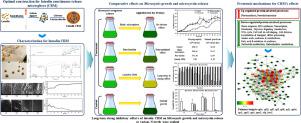Water Research ( IF 12.8 ) Pub Date : 2021-07-20 , DOI: 10.1016/j.watres.2021.117448 Biying Li 1 , Jieming Li 1 , Guangqi An 1 , Caihong Zhao 1 , Chengyu Wang 1

|
Microcystis-dominated cyanobacterial blooms (MCBs) severely threaten ecological health by causing hypoxia and releasing microcystins (MCs). Luteolin has potential as low-cost eco-safe algaecide against Microcystis, but to enhance sustainability of its algicidal effect and elucidate underlying mechanisms at proteomic level are urgently desirable. This study optimally constructed continuous-release microsphere (CRM) of luteolin with strong solidity and durability even after long-term immersion. Applying luteolin CRM, this study developed a long-term algicidal option to strongly inhibit Microcystis growth and MC-release until 49 days, with inhibition ratios of growth and MC-release (both ≥98%) and inhibitory effect-lasting time (nearly 50 days) of CRM superior to most former reports, and long-term strong inhibitory effects of CRM on Microcystis growth and MC-release kept stable at various nitrogen levels. Also, luteolin CRM rendered extracellular MCs content decrease to nearby acceptable threshold for drinking water. These signified a promising prospect of luteolin CRM in sustained effective control against toxigenic MCBs in waters of different eutrophic states. Comparative proteomic analysis showed that luteolin CRM significantly up-regulated photosynthesis and protein homestasis, but down-regulated other processes including stress response, MC-synthesis/release, glycolysis, amino acid synthesis, fatty acid synthesis/β-oxidation, tricarboxylic acid cycle, transcription, translation, transport, cell shaping and cell division. These implied that continuous stress of luteolin released from CRM induced Microcystis proteome towards a shift of higher energy storage but lower energy release/consumption, which largely disturbed its physiological metabolic processes and thus negatively impact its growth. Proteomics results shed newly deep insights on algicidal mechanisms of flavonoid in the form of CRM.
中文翻译:

木犀草素连续释放微球对微囊藻生长和微囊藻毒素释放的长期强烈抑制:最佳构建、表征、效果和蛋白质组学机制
以微囊藻为主的蓝藻水华 (MCB) 通过导致缺氧和释放微囊藻毒素 (MC) 严重威胁生态健康。木犀草素具有作为针对微囊藻的低成本生态安全除藻剂的潜力,但迫切需要提高其除藻效果的可持续性并阐明蛋白质组学水平的潜在机制。本研究优化构建了木犀草素连续释放微球(CRM),即使在长期浸泡后也具有很强的坚固性和耐久性。应用木犀草素CRM,该研究开发了一种长期的杀藻方案,强烈抑制微囊藻的生长和MC-释放直到49天,生长和MC-释放的抑制率(均≥98%)和抑制作用持续时间(近50天)的 CRM 优于大多数以前的报告,CRM 对微囊藻生长和 MC 释放的长期强抑制作用在各种氮水平下保持稳定。此外,木犀草素 CRM 使细胞外 MCs 含量降低到附近可接受的饮用水阈值。这些表明木犀草素 CRM 在持续有效控制不同富营养状态水域中的产毒 MCB 方面具有广阔的前景。比较蛋白质组学分析表明,木犀草素 CRM 显着上调光合作用和蛋白质稳态,但下调其他过程,包括应激反应、MC 合成/释放、糖酵解、氨基酸合成、脂肪酸合成/β-氧化、三羧酸循环、转录、翻译、运输、细胞成形和细胞分裂。这些暗示从 CRM 释放的木犀草素的持续压力诱导微囊藻蛋白质组向更高的能量存储但更低的能量释放/消耗转变,这在很大程度上扰乱了其生理代谢过程,从而对其生长产生负面影响。蛋白质组学结果对 CRM 形式的黄酮类化合物的杀藻机制提供了新的深入见解。



























 京公网安备 11010802027423号
京公网安备 11010802027423号